
Refer to the exhibit. Router 1 and Router 2 were installed in the data center. Router 1 is the core router in the network, but it fails to establish an OSPF peering with Router 2. and customer traffic is unable to pass. Router 1 also reports an increase in CPU and memory usage. However, the CPU for R2 is stable. Which action resolves this issue?

Refer to the exhibit. The link between Office A and Office B is running at 90% load, and occasionally the CPU on router R1 is overloaded. The company implemented QoS for business-critical applications at both offices as a temporary solution. A network engineer must update the R1 configuration to 600 ms to reduce CPU load and limit downtime after connection failure to avoid data loss. Which action meets this requirement?
A network operator working for a telecommunication company with an employee Id: 4065 96080 it trying to implement BFD configuration on an existing network of Cisco devices Which task must the engineer perform to enable BFD on the interfaces?
Why is the keyword none needed when implementing management plane security using TACACS?
Refer to the exhibit.

A network engineer is deploying SNMP configuration on client's routers. Encrypted authentication must be included on router 1 to provide security and protect message confidentially. Which action should the engineer perform on the routers to accomplish this task?
A network engineer is configuring Flexible NetFlow and enters these commands
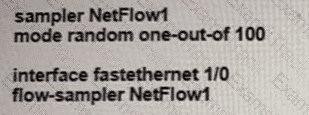
What are two results of implementing this feature instead of traditional NetFlow? (Choose two.)
Refer to the exhibit.
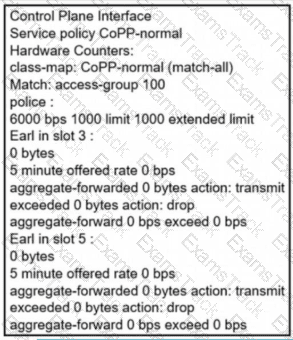
Which show command shows statistics for the control plane policy and is used to troubleshoot?
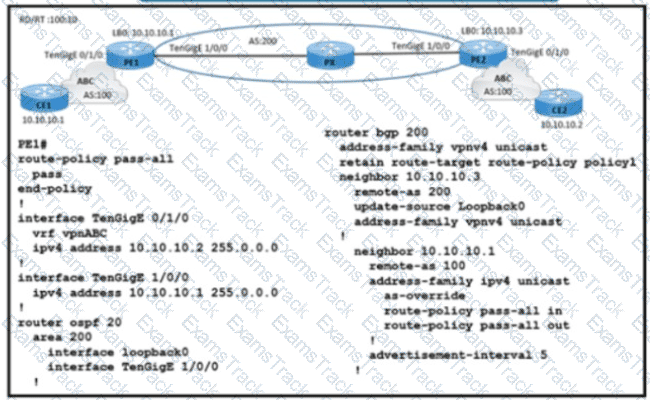
Refer to the exhibit. A service provider engineer Is configuring the connection between CE1 and CE2. AS 200 of the service provider and AS 100 of enterprise ABC should connect using BGP. The engineer already completed the configuration of VRF RT 100:10 of enterprise ABC. Which configuration must the engineer apply on PE1 to meet the requirement?

A network engineer Is implementing a QoS policy for outbound management traffic classification and marking on a CPE device with these requirements:
• Management protocols must be marked with DSCP AF class 2 w4h low drop probability.
• Monitoring protocols must be marked with DSCP AF class 1 with low drop probability.
• All remaining traffic must be marked with a DSCP value of 0.
Which configuration must the engineer implement to satisfy the requirements?
A)
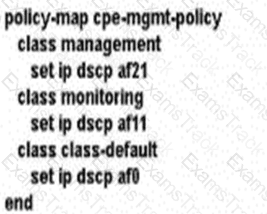
B)
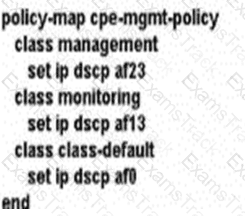
C)
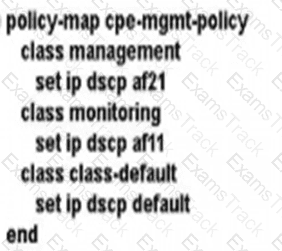
D)
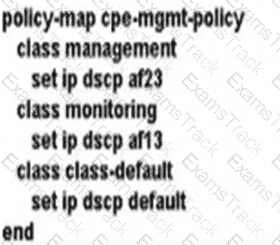
The administrator of a small company network notices that intermittent network issues occasionally cause inbound notifications to its SNMP servers to be lost. Which configuration must the administrator apply so that the SNMP servers acknowledge the notifications that they receive?
Which characteristic describes prefix segment identifier?
Which Cisco Software OS uses microkernel architecture?
Which feature will an operator use while implementing MPLS TE on customer's network, to prevent an LSP from using any overseas inks?

Refer to the exhibit. A regional company is implementing a network-health monitoring solution on their Cisco ISR routers to monitor network performance metrics and gather real-time data. The router R1 Ethernet interface, GigabitEthernet0/0, is assigned IP address 192.168.1.1/24, and basic IP addressing and connectivity to the data-collection server have already been configured. A network engineer must update R1 to ensure secure and reliable data transmission to the monitoring server, which is located at IP address 192.168.50.50 on port 50051. To achieve secure communication, the configuration must comply with RFC 5246, and to ensure reliable data transmission, it must follow RFC 793. Which command must the engineer execute to configure data collection?
|
PDF + Testing Engine
|
|---|
|
$52.5 |
|
Testing Engine
|
|---|
|
$40.5 |
|
PDF (Q&A)
|
|---|
|
$34.5 |
Cisco Free Exams |
|---|

|